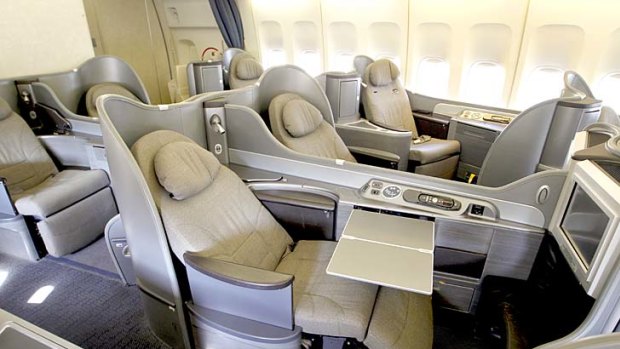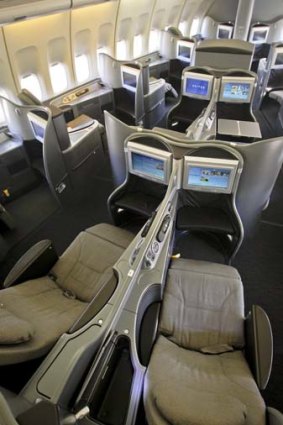This was published 12 years ago
Travel shock: US airlines deliver good service

The new first class cabin on a United Airlines 747 plane. US airlines are spending nearly $US2 billion to upgrade long-neglected lounges and aircraft.Credit: AP
I’m tempted to treat this like a UFO sighting, but there have indeed been credible reports of an outbreak of airline sevice in the USA. American airlines, which have a reputation for treating everyone like cattle, have finally worked out that, if they look after their best customers, they’ll keep coming back.
That is not to say that service up and down the plane has improved: if you pay peanuts and sit down the back, nothing has changed.
But US airlines are profitable after a disastrous decade in which they lost more than $US50 billion between 9/11 and the GFC and, having put themselves through such traumatic aversion therapy, have pledged they’ll never go there again.
Associated Press reports the US industry collectively is spending almost $US2 billion to upgrade amenities for their highest-paying customers.
“On the most profitable international routes, high flyers are being treated with preflight champagne, flat-screen TVs and seats that turn into beds,” AP reports. “Flight attendants greet them by name, hang up jackets and serve meals on china.”
In the country that invented airline industry deregulation, the news is greeted with a level of astonishment. For most of the past 30 years, there has been no room for anything but airline accountants prowling the check-in desks and the back offices looking for savings.

US airlines have poor reputations for service, but that may be changing.Credit: AP
Most of the new service effort is on international routes to and from the US. First-class and business-class passengers make up only 8 per cent of international travellers but account for 27 per cent of revenue, according to the International Air Transport Association. With a discount economy ticket between Chicago and Beijing costing around $1000 return, business class costs $4000 and first class $12,000.
"There is a war going on for the profitable passenger," says Henry Harteveldt, of consultants Atmosphere Research Group. Especially on international routes, there’s now an emphasis on product quality to attract premium passengers: lie-flat beds are a minimum requirement in business class, along with tasty food and good business lounges on the ground.
“They're now realising that they need to offer a competitive product to attract the highest-dollar passengers,” says Gary Leff, of US frequent flyer site MilePoint.
Economy passengers are also seeing some improvements these days, such as live TV and Wi-Fi service on select airlines. And they can enjoy other small luxuries for a fee. Seats with a few extra inches of leg room start at $9. Daily lounge passes cost $50. American even offers a celebrity treatment, with an agent escorting passengers from the curb to the gate for $125.
But for the vast majority of passengers, the gap is growing between the front of the plane and the back. That's because the airlines know what matters to the average traveller.
"They want their luggage. They want to arrive on time. They want the airplane to be clean," says Andrew Nocella, US Airways senior vice-president of marketing. “Most importantly, they want a low fare.”
But foreign influences are finally seeping into US domestic airline service. The Sir Richard Branson-backed Virgin America has so far burned more than $US660 million in establishing a new coast-to-coast US network.
Chief executive David Cush says he wants Virgin America to be recognised for superior quality. The San Francisco-based airline is routinely ranked among the favourites in customer surveys.
Virgin America's fleet of brand-new Airbus A319s and A320s seating 119 to 146 people is equipped with TVs for every passenger, colorful mood lighting and wi-fi. Instead of flight attendants dictating meal times, passengers buy food when they want it by pressing a few buttons on their TV.
“If you talk to people about what is most frustrating about air travel, what comes out is the loss of control,” Cush says. “We've been pushing to give people control again.”
Cush acknowledges there has been some copying as he works to create the Californian version of New York’s JetBlue, a highly-rated low-cost carrier with frills.
“JetBlue came around and had a different type of service,” Cush says. “That opened my eyes.
“The biggest difference is our in-flight entertainment system. It's a nine-inch screen — larger than JetBlue. We've got live TV, on-demand movies, about 3000 MP3s.
“We have food and drink on-demand. We're the only airline in the world that has it. You order from the seatback, swipe your credit card. They see seat 12C wants a turkey sandwich and a Heineken and bring it to you on a tray. Carts aren't blocking the aisles.”
Is service improving on US international airlines? Have you noticed an improvement on US domestic airlines? Have you tried one of the new airlines like Virgin America or JetBlue? How does Australian airline service compare?
Sign up for the Traveller Deals newsletter
Get exclusive travel deals delivered straight to your inbox. Sign up now.